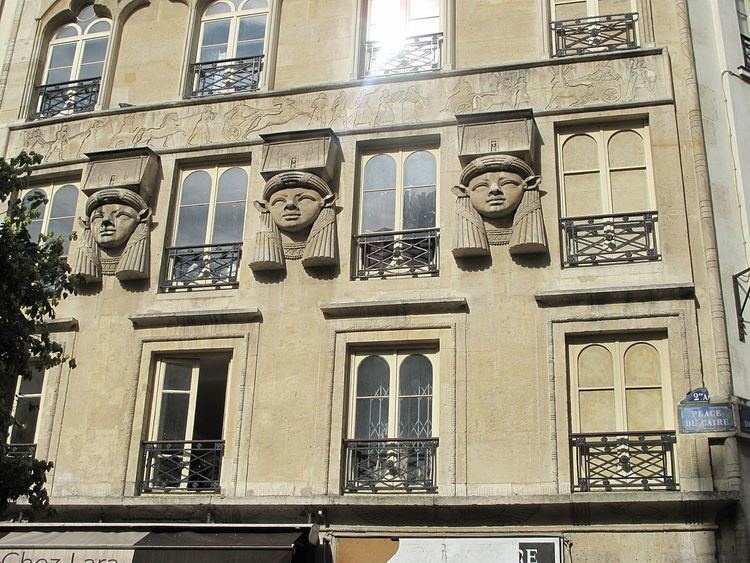 | ||
Egyptian revival is an architectural style that uses the motifs and imagery of ancient Egypt. It is attributed generally to the public awareness of ancient Egyptian monuments generated by Napoleon's conquest of Egypt and Admiral Nelson's defeat of Napoleon at the Battle of the Nile in 1798. Napoleon took a scientific expedition with him to Egypt. Publication of the expedition's work, the Description de l'Égypte, began in 1809 and was published as a series through 1826. However, works of art and architecture (such as funerary monuments) in the Egyptian style had been made or built occasionally on the European continent and the British Isles since the time of the Renaissance.
Contents
Egyptian influence before Napoleon
The most important example is probably Gian Lorenzo Bernini's obelisk in the Piazza Navona in Rome. It influenced the obelisk constructed as a family funeral memorial by Sir Edward Lovatt Pierce for the Allen family at Stillorgan in Ireland in 1717, one of several Egyptian obelisks erected in Ireland during the early 18th century. Others may be found at Belan, County Kildare; and Dangan, County Meath. The Casteltown Folly in County Kildare is probably the best known, albeit the least Egyptian-styled.
Egyptian buildings had also been built as garden follies. The most elaborate was probably the one built by Frederick I, Duke of Württemberg in the gardens of the Château de Montbéliard. It included an Egyptian bridge across which guests walked to reach an island with an elaborate Egyptian-influenced bath house. Designed by the duke's court architect, Jean Baptiste Kleber, the building had a billiards room and a "bagnio".
Post-Napoleonic era
New after the Napoleonic invasion was a sudden increase of the number of works of art and the fact that, for the first time, entire buildings began to be built to resemble those of ancient Egypt. In France and Britain this was at least partially inspired by successful war campaigns undertaken by each country while in Egypt.
According to David Brownlee, the 1798 Karlsruhe Synagogue, an early building by the influential Friedrich Weinbrenner was "the first large Egyptian building to be erected since antiquity." According to Diana Muir Appelbaum, it was "the first public building (that is, not a folly, stage set, or funeral monument) in the Egyptian revival style."
A street or passage named the Place du Caire or Foire du Caire (Fair of Cairo) was built in Paris in 1798 on the former site of the convent of the "Filles de la Charité". In 1828 a building with Egyptianizing detail including large Hathor heads and a freize by sculptor J. G. Garraudwas built at No. 2. Place du Caire. Among the earliest monuments of the Egyptian revival in Paris is the Fontaine du Fellah in Paris, built in 1806. It was designed by François-Jean Bralle. A well-documented example, destroyed after Napoleon was deposed, was the monument to General Louis Desaix in the Place des Victoires was built in 1810. It featured a nude statue of the general and an obelisk, both set upon an Egyptian revival base. Another example of a still standing site of Egyptian Revival is the Egyptian Gate of Tsarskoe Selo, built in 1829.
One of the first British buildings to show an Egyptian revival interior was the newspaper office of the Courier on the Strand in London. It was built in 1804 and featured a cavetto (coved) cornice and Egyptian-influenced columns with palmiform capitals. Other early British examples include the Egyptian Hall in London, completed in 1812, and the Egyptian Gallery, a private room in the home of connoisseur Thomas Hope (1769-1831) to display his Egyptian antiquities, and illustrated in engravings from his meticulous line drawings in his book Household Furniture (1807), were a prime source for the regency style of British furnishings.
Later revivals
Egyptian revival architecture enjoyed considerable popularity in other countries as well. The first Egyptian revival building in the United States was the 1824 synagogue building of Congregation Mikveh Israel Synagogue in Philadelphia, Pennsylvania It was followed by a series of major public buildings in the first half of the 19th century including the 1835 Philadelphia County Prison, Philadelphia, Pennsylvania, United States,the 1836 Fourth District Police Station in New Orleans and the 1838 New York City jail known as the Tombs. Other public buildings in Egyptian style included the 1844 Old Whaler's Church in Sag Harbor, New York, the 1846 First Baptist Church in Essex, Connecticut, the 1845 Egyptian Building of the Medical College of Virginia in Richmond and the 1848 United States Custom House in New Orleans. The most notable Egyptian structure in the United States was the Washington Monument, begun in 1848, this obelisk originally featured doors with cavetto cornices and winged sun disks, later removed.
The South African College in the then-British Cape Colony features an "Egyptian building" constructed in 1841; the Egyptian revival building of the Cape Town Hebrew Congregation is also still standing.
The Great Synagogue was Australia's first Egyptian revival building, followed by the Hobart Synagogue, the Launceston Synagogue and the Adelaide Hebrew Congregation, all by 1850. The earliest obelisk in Australia was erected at Macquarie Place, Sydney in 1818.
Discovery of Tutankhamun's tomb
The expeditions that eventually led to the discovery in 1922 of the treasure of Tutankhamun's tomb by the archaeologist Howard Carter resulted in a 20th-century revival. The revival during the 1920s is sometimes considered to be part of the art deco decorative arts style. This phase gave birth to the Egyptian theatre movement, largely confined to the United States. The Egyptian revival decorative arts style was present in furniture and other household objects, as well as in architecture.
